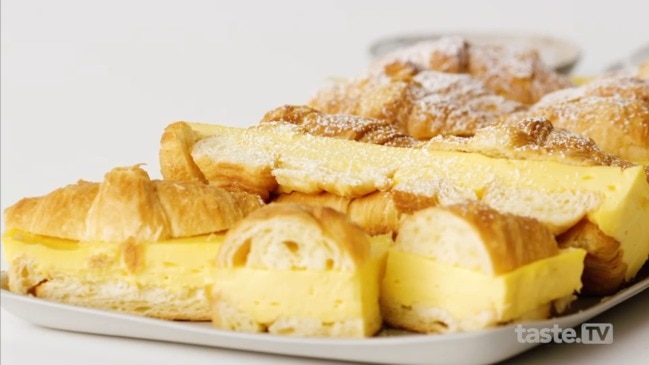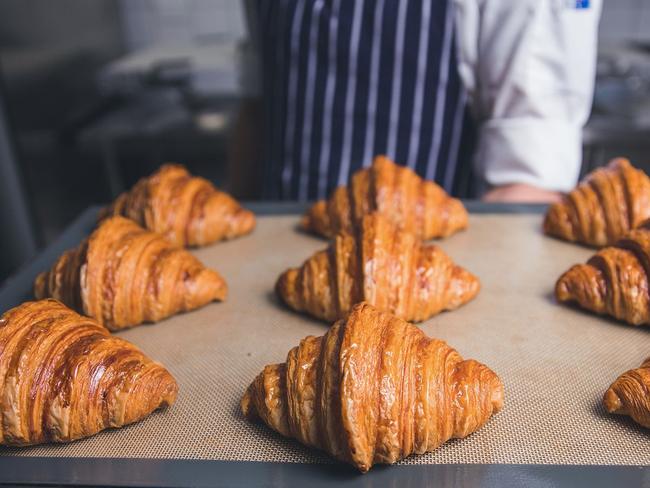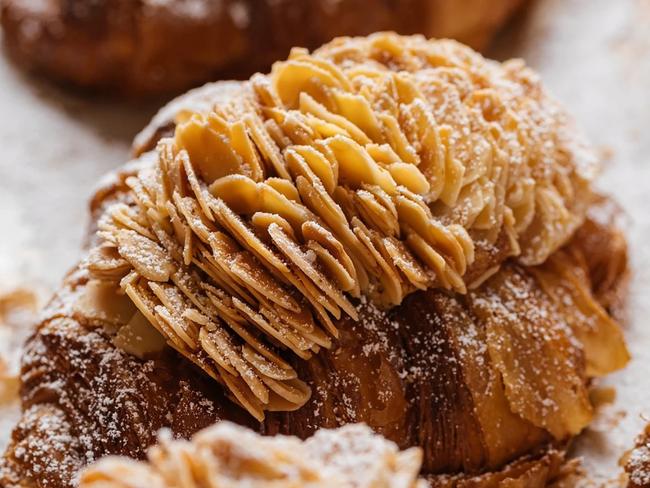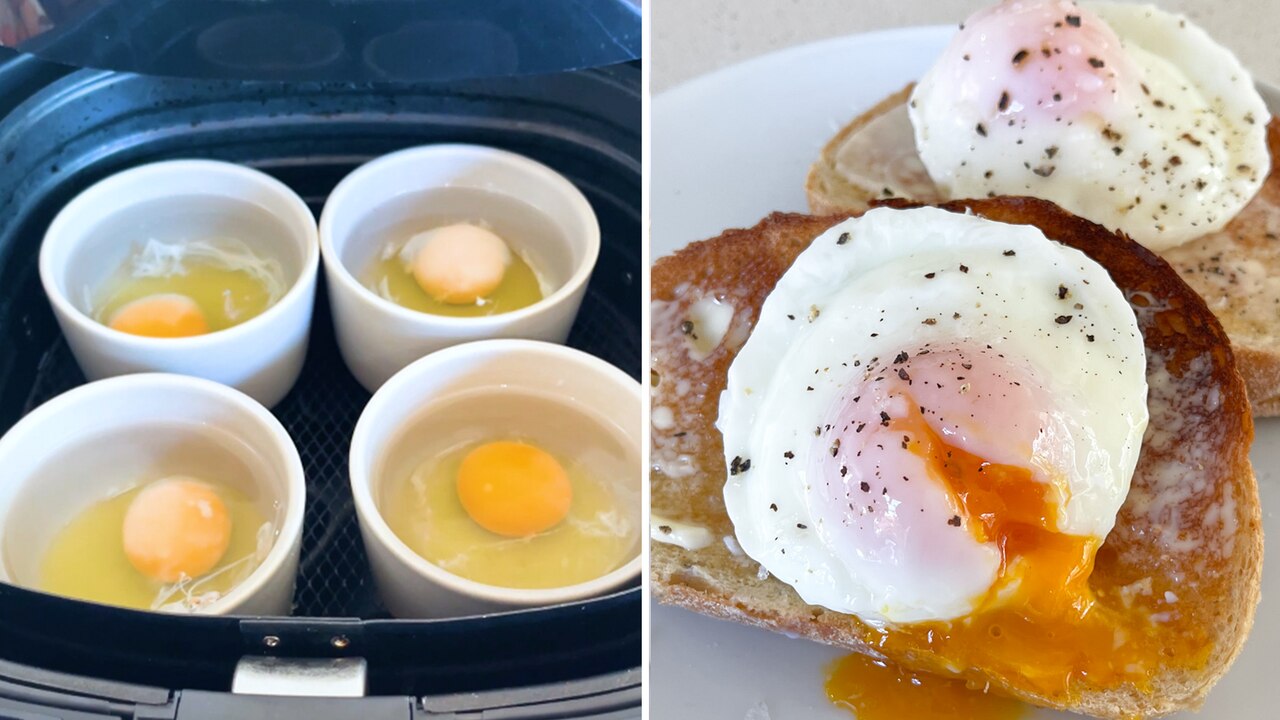It’s time we stopped doing this to croissants
Is there a point when chefs go too far with our favourite foods?

Food
Don't miss out on the headlines from Food. Followed categories will be added to My News.
You can’t reinvent the wheel, but nothing can dissuade the enthusiastic bakers of the world from their creative corruption of another great human accomplishment: the croissant.
The flaked pastry crescent has been around since the Renaissance, and in some stories it harks back to Vienna, Austria as an edible celebration of the end of the Ottoman Empire.
The modern croissant was developed when French pastry chefs replaced the traditional brioche dough with a yeast-leavened and laminated dough.

Wherever it came from, the crescent or moon shaped pastry has touched our hearts as thoroughly as the butter within has flirted with our arteries.
It’s been ten years since pastry chef Dominique Ansel broke with centuries of European tradition by deep-frying croissant dough, filling it and frosting it like a jam doughnut and calling it a cronut. And still professional bakers continue to push the limits of what croissants can become.
The crookie is the latest mash up in the croissant-Frankenstein world; a mad-scientist construction that delivers something sweet, chewy and flaky at once, to much furor. The crookie originated in the famed Paris institution Boulangerie Louvard, and has since been spotted in New York and here in Australia. Miss Sina in Sydney’s Marrickville jumped on the gimmick first-ish, and Bissel B Bakery in Melbourne’s Richard does a twist by rolling cookie dough layers with the croissant dough before baking.

Not content with the elegant baton of dark chocolate snuggled within the pastry to make a pain au chocolat, New York based baker Amadou Ly has made a croissant baguette, by which a sheet of croissant dough is wrapped around a baguette dough and together they’re pinched, rolled and baked to create an extra flaky and crusted baguette.
Related story: Croissant cubes are everything you love about the laminated pastry, squared

Croissants falling victim to new shapes, they’re sporting cookie swirls or chocolate stripes, and appearing as laminated cubes. While other pastry trends have come and gone – good riddance, cake pops – bakers of the world continue to fiddle with this, the most enduring and classic example of pastry perfection. But why, ask traditionalists everywhere. Comments on delicious.’ social media gasp at the latest rendition.
“Why ruin a perfectly good croissant?”
A croissant makeover is akin to asking the Mona Lisa to book in for her botox, her lip plump, her booty lift. The result is never better-than: you can’t better perfect. You can use it to inspire the creation of something else, just don’t call it the Mona Lisa.
There’s something blatant in the play-with-words plagiarism happening around the croissant right now. The Cronut started it, and now we have croissant cubes and the cookie croissant. The $1500 Hermès Chypre Sandal was borrowed endlessly last summer by high street designers, who made tiny tweaks and called it their own. They didn’t name it the Hermedupe or the Replihermè.
Home Croissanterie in Balmain makes croissants, and they’re wonderful. Home uses the same buttery dough as a launchpad to make all manner of other items. They weave chocolate dough and plain dough to create an intricately striped pastry, then stuff it with butter and chocolate chips to make “chocolate pain Suisse”.
Related story: delicious. 100: best croissants in Australia

It’s a remarkable and worthy contender for breakfast on the weekend, just don’t call it a croissant. Home’s “potato and sea salt” creation involves thinly sliced potatoes that are rolled through the would-be-but-isn’t croissant dough, then baked until crispy and finished with extra virgin olive oil and flaky sea salt. It’s sold at a croissanterie, but it isn’t a croissant. It’s a scroll, or a baked item, or “the potato one”, according to the customers queuing.
Kate Reid at Lune Croissanterie in Melbourne has claimed that Ansel and his Cronut likely saved her bakery. When she opened her all-croissant bakery in 2012 business was slow, leading her to believe then that the French classics, however perfect, did not bring enough customers.
Taking the croissant (re)creation upon herself, Reid used the methodology behind the almond croissant but made it macadamia-nut frangipane and salted caramel. Then came her phenomenally popular combinations like peanut butter and chocolate, Vegemite and cheese, and pastrami and sauerkraut.
The idea of buttery, flakey pastry with something sharp, something salty, umami or sweet is not new. There is the Chinese subing, Danish pastry, South Asian roti paratha, Eastern European strudel, North African msemen and the Balkan phyllo. Each fold butter or fat into dough, then shape, pinch and fold, including other flavours according to their local traditions and produce.
Some recent iterations won’t make traditionalists baulk as much as smirk. Amateur baker Gautier Coiffard learned how to make traditional croissants during lockdown in his Brooklyn home, while his wife created Instagram posts of his work, attracting people to their online bakery, L’Appartement 4F.
Related story: Lune Croissanterie confirms it’s coming to Sydney and it better not flake

He made a raspberry croissant that went viral, followed by the invention of croissant cereal – tiny croissants that are glazed with cinnamon sugar syrup and are small enough to be eaten with a spoon. Croissant cereal cost US$50 a box due to the manual labour involved in rolling each tiny croissant by hand, and it’s perpetually out of stock.
The croissant cube, meanwhile, is a cube-shaped croissant. It’s a bright young thing, a perky glazed cube made from the same yeasted dough as the croissant, but stacked in squares and baked in a mould. Flavoured creams and gels can be pumped in the centre, and there’s plenty of crunch to her bite.
We cannot yet know whether our fascination with this new thing, or the next, is merely fleeting or whether it will move us, our hearts, enough to stay for a while. After all, the croissant cube and its ilk are just another pastry, albeit lovely, standing on the shoulders of a giant.
Related story: A plant-based cafe and bakery has opened in Glebe and it’s making vegan croissants
For more food, travel and lifestyle news, go to delicious.com.au


